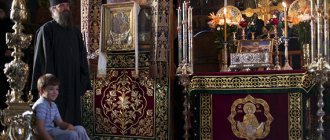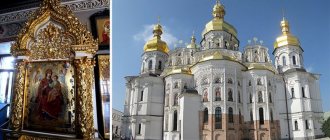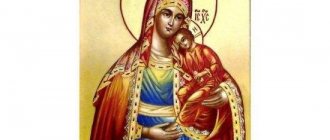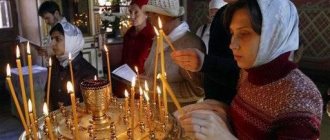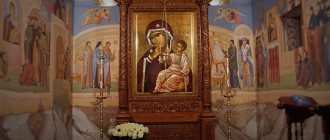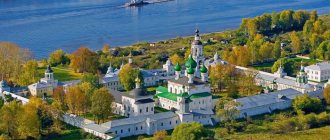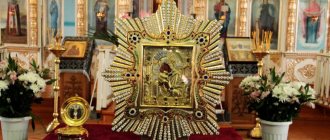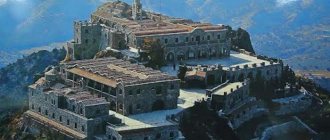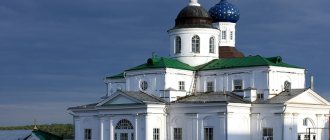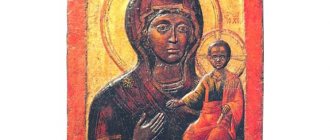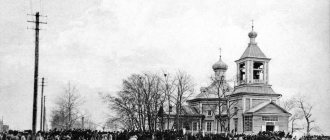The miraculous icon of the Mother of God, called “The All-Tsarina (Pantanassa)”, is located on Holy Mount Athos in Greece. She resides in the Vatopedi Monastery, in the cathedral church of the monastery, to the left of the royal doors. The time of its writing dates back to the 17th century.
An ancient monastic legend says that one day a certain young man approached the icon. At that moment, the face of the Mother of God shone with a wondrous light, and an invisible force threw the young man to the floor. In fear, he ran out of the temple and with tears confessed to the elders that he had led a sinful life and practiced witchcraft. Thus, the Most Holy Theotokos revealed a miracle from Her image, turned the young man away from wickedness and set him on the path of repentance.
The icon of the Most Blessed Lady, called “The All-Tsarina,” is deeply revered on the Holy Mountain and far beyond its borders. This image has become famous for numerous miracles of healing from a painful and deadly disease that has become extremely widespread in the modern world - cancer.
A revered copy of an ancient miraculous icon, specially made at the Vatopedi Monastery and brought to Russia, is located in the Moscow Novospassky Stauropegial Monastery. Prayer services are performed in front of it every day, and on Sundays prayer services are served with the blessing of water.
The Mother of God reveals Her ineffable mercy and grants healing to all who turn to Her in prayer with faith and love before Her glorified image.
The celebration takes place on August 18/31.
Troparion, tone 4
With the joyful image of the honest All-Tsarina, / with the warm desire of those seeking Thy grace, save, O Lady; / deliver those who come running to You from circumstances; / Protect Your flock from every misfortune, // always calling for Your intercession.
PRAYERS TO THE HOLY VIRGIN
First prayer
O All-merciful, venerable Mother of God, Pantanassa, All-Queen! I am not worthy, but come under my roof! But as a merciful and gracious Mother of God, say the word, may my soul be healed and my weak body strengthened. For you have an invincible power and all your words will not be exhausted, O All-Tsaritsa! You beg for me. You begged for me. May I glorify Your glorious name always, now and forever. Amen.
Second prayer
O Most Pure Mother of God, All-Tsarina! Hear our much-painful sigh before Your miraculous icon, brought from the inheritance of Athos to Russia, look upon Your children, those suffering from incurable ailments, who fall to Your holy image with faith! Just as a winged bird covers its chicks, so You, now and ever-living being, have covered us with Your multi-healing omophorion. Appear with patience and weakness. There, where hope disappears, awaken with undoubted Hope. There, where fierce sorrows prevail, there, where the darkness of despair has settled in souls, let the ineffable light of the Divine shine forth! Comfort the faint-hearted, strengthen the weak, grant softening and enlightenment to hardened hearts. Heal Your sick people, O All-Merciful Queen! Bless the minds and hands of those who heal us, may they serve as an instrument of the Almighty Physician Christ our Savior. As if You are alive and present with us, we pray before Your icon, O Lady! Extend Your hand, full of healing and healing, Joy to those who mourn, Consolation to those in sorrow, so that we soon receive miraculous help, we glorify the Life-Giving Indivisible Trinity, Father, Son, and Holy Spirit forever and ever. Amen.
“The Tsarina”: the icon that conquers cancer
Athos shrine
The miraculous icon of the Mother of God, called “The All-Tsarina” (that is, “The All-Mistress”, “The All-Mistress”), was painted in the 17th century and is located on Athos, in one of the ancient Greek monasteries - Vatopedi. Already at that time, the monks began to notice that prayer in front of this image of the Mother of God brought relief and healing.
The first miracle of “The Tsaritsa” was the deliverance of one person from sorcery.
An amazed witness of this healing, the monk Vatopeda made the first copy of the “healing” icon.” Over time, this image of the Virgin Mary became known throughout the world.
People of different faiths came to the “Vsetsaritsa”, but everyone prayed - begged for healing.
Here are just a few cases of help from the miraculous icon that have already occurred in our time.
“A Muslim family came from Turkey to Greece for examination: their five-year-old son felt worse and worse, lost consciousness, and was out of breath while walking quickly. Doctors detected a murmur in the heart, warning that it might not withstand the slightest increase in physical activity. On the phone, the boy’s father “accidentally” saw a program about the miraculous icons of Mount Athos, among which was the “Vsetsaritsa”. He made inquiries on the Internet and came with his son to the Vatopedi Monastery. The priests of the monastery led them to the icon, where the father of the sick child fervently prayed in his own words. The next examination revealed that the child was completely healthy. Father and son returned to Vatopedi and were baptized there.”
In Russia, the image of the Mother of God “The Tsaritsa” is known as an icon that is prayed to “for cancer.” This disease, by the way, is not new at all, but was known back in the days of the Ancient Egyptian papyri of 1600 BC, which talk about what a serious illness it is. Even then, both adults and children suffered from cancer.
How “The Tsaritsa” ended up in Moscow
In 1991, at the Moscow Children's Oncology Center on Kashirskoye Shosse, a little patient noticed that light was shining from the “Vsetsaritsa” icon (a small paper image). She told doctors and parents about this.
The adults nodded their heads in disbelief until the glow was noticed by other children in the ward.
And soon some of the adults will too. The girl’s incurable illness began to respond to treatment. Parents and doctors were all shocked.
A little later, on the initiative of the Community of Mercy in honor of St. John of Kronstadt at the Moscow Children's Oncology Center, the first copy of the “Vse Tsarina” icon was made. With the blessing of the rector of the Vatopedi monastery, Archimandrite Ephraim, the image was painted by a Russian icon painter, who was one of the brethren of Vatopedi.
Prayers for sick children and their parents began to be served in front of the icon.
It was at the Oncology Center that miraculous help was provided to many suffering people.
Soon it was decided to transfer the miraculous image to the Church of All Saints in Krasnoye Selo (now Alekseevsky Monastery). But the image of the “All-Tsarina” is regularly brought back to the Oncology Center for prayer services.
Help
Cases of healing and help from the image of the “Vsetsaritsa” in the Church of All Saints in Krasnoe Selo of the Alekseevsky Monastery are collected and carefully examined. Here are some such evidence:
One of the parishioners of the temple in Krasnoye Selo wrote to its rector: “Having visited the temple in April 2003, I bought holy oil from the icon of the Mother of God “The All-Tsarina.” She anointed her eye in several places and prayed to the Mother of God. Improvement occurred within half an hour, then I fell asleep. Through prayers and through the intercession of the Most Holy Theotokos, the Lord healed my eye.”
“A middle-aged man was diagnosed with liver cancer. Doctors refused to perform the operation. He began to go to the Church of All Saints every day for a prayer service to the “Vse Tsarina.” After some time he felt better, he underwent repeated examinations, and it turned out that there was no cancer.”
“My father was diagnosed with stage IV stomach cancer with metastases in the lungs,” writes Svetlana. “From acquaintances and friends, his wife learned about the miraculous icon “The Tsaritsa.” She came to the evening service and prayed to the Most Holy Theotokos and read the akathist. Then, for a week, every day I read the akathist at home in front of the purchased icon “The Tsaritsa” and prayed to it. And a miracle happened: the doctors, preparing my father for a serious operation, did not find any cancerous tumor, and the dark spots in the lungs turned out to be not metastases, but traces of a smoker’s bronchitis. The doctors’ conclusion is a scarring, healing stomach ulcer.”
Where to pray before the “Vsetsaritsa” in Moscow
In Moscow, you can venerate the image of the Most Holy Theotokos “Vsetsaritsa” in the Alekseevsky Monastery (Church of All Saints), in the Novospassky Monastery and in the Church of the Holy Martyr Tatiana at Moscow State University.
A copy of the miraculous icon was brought to the Church of the Holy Martyr Tatiana in 2005 - it was presented to the church by parishioners who returned from a pilgrimage to Athos. Since then, a prayer service with an akathist has been held here regularly - once every two weeks on Tuesdays.
A copy of the Greek icon of the “Vsetsaritsa” was delivered to the Novospassky Monastery in 1997. In 2000, she cast myrrh, and evidence of healings appeared. At the monastery, the akathist is read daily before the miraculous icon, and prayers are served on Sundays.
In the Alekseevsky Monastery, in the Church of All Saints, in Krasnoe Selo, prayer services with an akathist before the image of the “Vsetsaritsa” are performed every Sunday at 16:30. If a great holiday falls on Monday, the prayer service begins at 15:00.
The first images of "Pantanassa"
The first image of the “All-Tsaritsa” icon, dating from the 8th century, can be found in the Trigilian monastery, in Bethany (the modern city of Al-Azaria). The monastery was built in 780 and is now not functioning. The image survived only in fragments: the wall painting preserved the outlines of the Mother of God and the figures of the archangels.
Another icon belonging to the Panachrant type was donated to the Gregory Monastery (Athos) in the 14th century by the Moldavian ruler Stephen the Great. But it became famous as a miraculous icon only in the 17th century, when it fell into the hands of the Athonite elder Joseph the Hesychast. The story goes that the Monk Joseph transferred it from New Skete to Vatopedi as a blessing to the monastics there. Its original is still in the cathedral church of the Vatopedi Monastery on Mount Athos.
According to legend, in those ancient times, a young man wandered into the Vatopedi monastery, stopped in front of the icon and began to whisper some incomprehensible words. Suddenly, the most pure face of the Mother of God lit up with a flash, and the young man was thrown away by an unknown force.
After the monastery brethren raised the would-be prayer-man from his knees, he admitted that he was engaged in witchcraft and went into the temple not to pray at all, but to test the effect of magic on one of the images.
After this incident, the sorcerer sincerely repented and remained in the monastery as a novice, atoning for his guilt with zealous labor. The icon began to be revered as a shrine, patronizing all who suffered from evil spells and the evil eye.
Cases of recovery from cancer
In Russia, this image is known as the icon of the deliverer from cancer. The first people who were helped by “Vsetsaritsa” to overcome this terrible disease were the little patients of the Moscow Oncology Center on Kashirka. In 1991, one of the girls undergoing treatment noticed a strange glow emanating from a paper reproduction of “The Tsarina.” She told the adults about this, but they just shrugged it off. The glow did not disappear, and later other children, and even some of the medical staff, noticed it. The girl’s fatal illness began to recede, plunging doctors and parents into real shock.
On the initiative of the Community of Charity of Saint Righteous John of Kronstadt, created at the same center, the monks of the Vatopedi monastery reproduced a list (an exact copy) of “The Queen of All.” In 1995, he was transferred to the oncology center in Moscow and began to serve prayers for the health of sick children. Many of the center's patients then received miraculous healing.
On the feast of the Nativity of the Blessed Virgin Mary, fragrant drops of myrrh appeared on the image. The myrrh streaming was also repeated on another major church holiday - the Introduction, after which they decided to transfer the icon to the Alekseevsky Monastery in Krasnoe Selo. There she became famous for her numerous miracles, helping cancer patients regain physical health. Other copies were made from the Athos icon, many of which also became famous for their miracles.
This is interesting: In a serious illness, the prayer “To the Queen of All” helps
Novospassky stauropegial monastery, Moscow
The temple was founded by the thoughts of the blessed Prince Daniel, the son of the great Alexander Nevsky, who dedicated it to the name of the Savior. This was the first monastic refuge in Moscow, which began its life in the 13th century. At first it was located on the site of the modern Danilovsky Church, and after a few decades it was moved. The son of Prince Daniel, Saint John Kalita, who received the crown of ruler in 1328, wanted to have a monastic temple near his own mansion, after which the Novospassky Monastery was moved to the Kremlin Borovitsky Hill, near the Church of the Transfiguration.
All their lives, Prince John and his family prayed decorously in the Stavropegial Monastery. Russian bishops also came here when they stayed in Moscow on diocesan business. Beginning in 1491, John the Third founded the cathedral church, which was a symbol of the Transfiguration of the Lord. Five years later, in 1496, it was consecrated according to all religious rules.
In the period from 1640 to 1642, through the efforts and finances of Mikhail Fedorovich, a residential stone building and a cathedral in honor of the Holy Mother of God were erected. At the same time, a large tented bell tower was built with a monastery named after His Holiness Sava the Sanctified. And in the last few years of his reign, Mikhail Fedorovich was engaged in the construction of the current Transfiguration Church and the Intercession Cathedral.
The Novospasskaya Church experienced difficult times during the invasion of Napoleon's troops. In the first days of the attack on the city, the shrine was destroyed by the enemy, and then an unexpected fire broke out. According to historians, the French dug holes near the monastery to plant explosives there and destroy the Stavropegic Cathedral. Fortunately, they did not have time to do this, and after some time, with the departure of enemy troops, it was restored and re-consecrated.
The year 1913 was marked by a great anniversary. Then the 300th anniversary of the Romanov mansion was celebrated, and Emperor Nicholas II visited the monastery in honor of the holiday. In the spring, on May 26, the ruler, moved by the inspiring and sincere singing of the church's folk choir, wished them good luck and a peaceful sky above their heads. It was not destined to live peacefully for long - at the end of the autumn of 1918, the Stavropegic Church was closed, and a maximum security concentration camp was built in its residence. The formerly holy site became a symbol of imprisonment and many deaths.
In 1990, on the day of the celebration of the Entry of the Virgin Mary, the Novospasskaya Church was returned to the Moscow Patriarchate. After this, anyone can go to the shrine to pray.
Photo of the Church of All Saints in Krasnoe Selo
Krasnoselsky Church of All Saints is “red” at any time of the year.
The parishioners are proud of their temple and especially its unusual “three-headed” bell tower.
This ship is rushing its parishioners into a bright future!
Icon of the Mother of God “Vsetsaritsa”
The miraculous icon of the Mother of God, called “The All-Tsarina”
(in Greek - “Pantanassa”) is located on Holy Mount Athos in Greece in the cathedral church of the Vatopedi monastery, to the left of the royal gates. This icon, small in size, was painted in the 17th century and, according to legend, was the blessing of the famous Elder Joseph the Hesychast on Athos to his disciples.
The icon depicts the Most Pure Virgin in a scarlet robe, seated on the royal throne. In Her arms is the Infant God with a scroll in his left hand and with a blessing right hand. With her right hand, the Mother of God points to Her Royal Son as the Savior of all people. In the background are two angels who reverently overshadow the Most Pure Virgin with their wings.
According to an ancient monastic legend, one day a young man approached the icon and began to mutter something inaudibly. Suddenly the face of the Mother of God shone with a wondrous light, some invisible force threw the young man away, and he fell to the ground. Rising, he ran in fear to the elder monks and with tears in his eyes confessed to them that he had led an ungodly life, practiced witchcraft, and had come to the monastery to test the power of his magic on the holy icons. The miracle that happened at the icon of the Most Holy Theotokos forever turned the young man away from witchcraft, directed him to the path of repentance and returned him to the path of a pious life. The miraculous image of the Mother of God “The Queen of All” is revered both on Athos and far beyond its borders. The very name of the icon - All-Mistress, All-Mistress - speaks of its special, all-encompassing power. Having demonstrated its miraculous power for the first time against magical spells, the “Tsarina of All” also has the grace of healing patients with cancer - the most terrible disease of modern humanity (and the spread of passion for magic, witchcraft and the occult throughout the Christian world can be compared to the defeat of the human body by a malignant tumor).
On August 11, 1995, a copy of the miraculous icon “The Tsaritsa” arrived in Russia - at the Moscow Children’s Oncology Center on Kashirka. At prayer services to the Mother of God “The All-Tsaritsa,” sick children and their parents pray with the hope of the heavenly help of the Intercessor and Healer.
What do people pray for to the icon of the Mother of God All-Tsaritsa?
The icon of the Mother of God, the All-Tsarina, both in Moscow and in other churches, is approached by people who themselves or their loved ones are faced with cancer. This icon is revered by Orthodox believers as miraculous specifically in the issue of cancer, which has been known to people since the 17th century, when the tumor was given the name not cancer, but “carcinoma”, translated into Russian as “crab” and “tumor”, which indicates a form of disease that most often resembles a crustacean creature. Hippocrates discovered such a tumor back in 1600 BC, giving it a name and the conclusion that at an early stage it can only be cured by surgery, but at a later stage it is better not to touch it, because there is no cure.
Children, parents, other relatives and friends turn to the icon with prayers. These are sad appeals from parents who believe in recovery until the very end and pray to the Mother of God for strength to overcome this path.
People also turn to the miraculous icon for other illnesses, before operations for which doctors do not give positive prognoses.
In the book of records of miraculous recoveries of people turning to the icon of the All-Tsaritsa, a case is described. After suffering a stroke, a man decided to check his well-being and underwent an MRI examination. The diagnosis shocked him, because after overcoming a stroke, he learned about brain oncology. Surgery was required. The patient decided to visit the Church of the Icon of the Mother of God the Tsaritsa for a blessing for a serious step. He was accompanied by his wife, who ordered a prayer service to the image of the Virgin Mary with the blessing of water, which the man took with him to the hospital. The saint’s daily prayers and drinking water gave a positive result - during the preoperative MRI examination, the tumor was not detected, which became a fact of miraculous healings of believers and sincerely praying Christians.
There are a lot of similar cases. They become known from the people themselves, who returned again to the All-Tsaritsa to thank her for her help.
Novospassky stauropegial monastery
Activity:
Churches, mosques, cathedrals, temples, chapels, monasteries, etc.
How to get to the Novospassky Stavropegic Monastery by public transport:
- Dinamovskaya (381m)
- Gvozdeva (Bolshiye Kamenschiki St.) (420m)
- Metro Proletarskaya (3rd Krutitsky lane)
How to get there by metro:
- Peasant outpost (690m)
- Proletarskaya (729m)
- Taganskaya
Data about the organization “Novospassky Stavropegial Monastery” is posted in the Moscow directory under the headings “Religious organizations”, “Religious institutions” and is registered at the address Moscow, Krestyanskaya Square, 10, building 12.
How to get to the temple?
The easiest way to visit Krasnoye Selo in Moscow and the Church of All Saints itself is to use the metro .
- The metro station closest to the temple is “Krasnoselskaya” (as we can see, the toponymy in this area is very diverse, the main thing is not to get confused).
- From the metro station, move to the left along Krasnoprudnaya Street, pass under the Rusakovskaya overpass, turn left again and move in the given direction until you see a fence made of red (red again!) brick. Voila, you are almost at your goal: on your right hand you will find the entrance to the Alekseevsky Monastery, to which the All Saints Church belongs.
A walk through the Novospassky Monastery: 20 years after the second birth (+ photo)
"Religious institutions" nearby:
- Church of the Sign of the Icon of the Mother of God in the Novospassky Monastery, Krestyanskaya Square, 10 building 13 (30m)
- Church of the Intercession of the Blessed Virgin Mary in the Novospassky Monastery, Krestyanskaya Square, 10 building 11 (40m)
- Church of the Resurrection of the Word on the Krutitsky courtyard, Krutitskaya street, 17 building 5 (470m)
- Church of Scientology, Taganskaya street, 9 (1km30m)
- RAIS, centralized religious organization, representative office in Moscow, Simonovsky Val street, 16 (1km40m)
- Pokrovsky stauropegial convent at the Pokrovskaya outpost, Taganskaya street, 58 (1 km 180 m)
- Temple of the Jerusalem Icon of the Mother of God behind the Pokrovskaya Zastavoy Talalikhina Street, 24 building 1 (1km360m)
"Religious organizations" nearby:
- Icon of the Mother of God “Vsetsaritsa”
- Novospassky Monastery in Moscow on Peasant Square
Church of All Saints in Krasnoe Selo - video
The modern life of the All Saints Church in Krasnoye Selo is full of joyful concerns: it operates an almshouse named after Tsarevich Alexy, parish and Sunday schools, an icon workshop, an Orthodox store with the mysterious name “Arina Rodionovna’s House,” a folk choir and a health camp for children. Since 2013, the monastery has revived its activities around the temple, and several other churches have also been added to it. People seeking peace and solitude come to wander through the quiet garden around the temple.
Whatever your soul craves, in the Krasnoselsky Church of All Saints you will find the beauty of Russian architecture, the peace of a place of worship, and simply joy for the heart.
Briefly about the Novospassky Monastery - a description for tourists and pilgrims
Address
: Moscow, Krestyanskaya Square, 10
Directions:
st. metro station "Proletarskaya", "Krestyanskaya Zastava"
Novospassky Monastery
- one of the most beautiful corners of Moscow with a happy destiny, which, despite many troubled periods of Russian history, has survived and preserved the entire beautiful ensemble of ancient temples.
History of the Novospassky Monastery in Moscow
The construction of the Novospassky Monastery began on Krutitsky Hill near the bank of the Moscow River in 1490 at the behest of the Grand Duke of Moscow Ivan III, and it was intended to move the brethren of the Spassky Monastery, founded in the 13th century by Prince Daniil of Moscow and located on the territory of the Moscow Kremlin. The new location chosen for the relocation of the monastery was of great strategic importance for the protection of the southern borders of Moscow. In subsequent years, the monastery more than once blocked the path to Tatar raids, and in the 17th century it successfully withstood the siege of Polish invaders.
Since the accession of the Romanov dynasty to the Russian throne, the Novospassky Monastery has found itself in a privileged position. The favor of the royal dynasty was due to the fact that the tomb of the Romanov family was located in the monastery. Thanks to the tutelage of Russian monarchs who made generous donations, the Novospassky Monastery turned into one of the beautiful monuments of Russian architecture. However, despite the glorious history, the repressions of the Soviet government did not bypass it. In 1918, the Novospassky Monastery was closed, and its territory began to be used as a forced labor camp, which existed until 1935. In 1935, most of the monastery buildings were transferred to the economic administration of the NKVD, and some were converted into communal housing. A happy year in the life of the monastery was 1968, when it was decided to reorganize it into the Museum of the History and Modern Practice of Restoration in the USSR. – Restoration work began, which lasted for many 20 years. But it never came to the point of opening the museum; in 1991, it was completely transferred to the Russian Orthodox Church. And from that moment on, monastic life began to revive again in the monastery.
Sights and temples of the Novospassky Monastery
Currently, the architectural ensemble of the Novospassky Monastery includes:
- Transfiguration Cathedral (years of construction: 1645—1649)
- Church of the Intercession (1673–1675)
- Temple of the Icon of the Mother of God “The Sign” (1793–1795)
- Walls and towers of the monastery (1640-1642)
- Gate bell tower with the Church of Sergius of Radonezh (1759–1785)
- St. Nicholas Church (1652)
- Chapel of the 300th anniversary of the Romanov dynasty (1913)
- Brethren Corps (1640–1644)
- Chambers of Patriarch Filaret (1620–1640)
In 1998, a complete copy of the memorial cross that stood in the Kremlin at the site of the murder of Grand Duke Sergei Alexandrovich was installed on the territory of the monastery, and in 2013, the monument “Four hundredth anniversary of the election of the Romanov dynasty to the kingdom” was erected.
And, of course, acquaintance with the Novospassky Monastery in Moscow will not be complete without visiting the Romanov tomb.
Attractions and shrines of the temple
- Exterior of the temple combines elements characteristic of traditional Russian architecture and romantic motifs. Unique in itself is the three-domed bell tower, adjacent to the temple and giving it a shape reminiscent of the outline of a ship.
- Iconostasis of the temple made of beautiful white marble in Russian-Byzantine style. The painting on the vaults and frescoes made by the masters of the Trinity-Sergius Lavra in a style imitating Byzantine are in amazing harmony with it.
- Near the temple was located the most prestigious in its time necropolis of the Novoalekseevsky monastery, where many outstanding figures found their final refuge: poet A. M. Zhemchuzhnikov, physicist P. N. Lebedev, philanthropist and faithful friend of P. I. Tchaikovsky Nadezhda von Meck, the family of K. S. Stanislavsky and many others. Unfortunately, the necropolis has not survived to this day.
- The temple is famous for its shrines: a list of the icon of the Mother of God “The All-Tsarina” and particles of the relics of Philaret of Moscow , considered a saint, the martyr Tatiana, who suffered for her faith, and Seraphim of Sarov, one of the most revered ascetics of the Orthodox Church.
icon of the Mother of God All-Tsaritsa
relics of Philaret of Moscow
Icon of the All-Tsarina
Unfortunately, in the troubled post-revolutionary years, the Romanov tomb was subjected to barbaric destruction. However, at the end of the 1990s, it was recreated along with the temple located in it in honor of the Venerable Roman the Sweet Singer. Although, of course, most of the tombs were lost forever.
If we continue the topic of losses of the Novospassky Monastery, then it is also worth mentioning the monastery necropolis, of which not a trace remains, and the icon “The Miraculous Image of the Savior Not Made by Hands.” Since 1917, the whereabouts of this icon have been unknown. Now in the Transfiguration Cathedral there is a preserved copy of the miraculous image.
However, at the moment the most famous icon of the Novospassky Monastery is the “Vsetsaritsa”. To pray at this icon, many believers specially travel from the most remote outskirts. “But the fact is that the miraculous icon of the Mother of God “The All-Tsarina,” kept on Mount Athos in the Vatopedi Monastery, is considered capable of healing from cancer. And especially for the Novospassky Monastery in Moscow, the monks of Vatopedi made an exact list of it in 1997. The “Vsetsaritsa” icon of the Novospassky Monastery is now also revered as miraculous, to which people turn for healing from cancer.
Since 2011, a museum of the history of the Novospassky Monastery has been operating within the walls of the monastery. You can sign up for a tour at the tour service, which is open from 10:00 to 17:30.
How to get to the Novospassky Monastery in Moscow
If you look at where the Novospassky Monastery is located on a map of Moscow, it is obvious that the closest metro stations to it are Proletarskaya and Krestyanskaya Zastava. To get from the metro to the Novospassky Monastery, you will have to walk along the 3rd Krutitsky Lane to Krestyanskaya Square, where the monastery is located. The entire short route will take just over 5 minutes.
The miraculous icon in the Novospassky Monastery, address
In 1997, another list of the miraculous icon appeared in the Russian capital. It was also made on Mount Athos and donated to the Novospassky Stavropegic Monastery, where it remains to this day. Three years after its appearance in the monastery, the image began to cast myrrh, and evidence of miraculous healings appeared. Every day, except for the days of Great Lent, prayer services are served before the image of the Mother of God, and on Sundays - prayer services with the blessing of water.
The image of the Mother of God “Vsetsaritsa” in the Novospassky Monastery
The monastery is located at the address: Moscow, Krestyanskaya Square, 10. The nearest metro stations, from which you can get to the monastery by the shortest route: Proletarskaya, Krestyanskaya Zastava and Taganskaya. From Proletarskaya to the temple complex it is only half a kilometer on foot. We need to move towards the Moscow River. After crossing the road through an underground passage, the majestic walls of the monastery will appear in front of you.
Temples dedicated to the icon of the Virgin Mary in Moscow
You can venerate the miraculous icon in the capital of our homeland at the following addresses:
- Church of the Icon of the Mother of God of All Tsaritsa at the clinic of the Moscow Research Institute of Orthopedics named after. P. A. Herzen, Moscow, 2nd Botkinsky Ave., 3;
- Church of the Icon of the Mother of God All-Tsaritsa at the Central Clinical Hospital No. 2 named after Semashko, Moscow, st. Budaiskaya, 2;
- Chapel of the Icon of the Mother of God All-Tsaritsa at the Central Clinical Hospital No. 2 named after Semashko, Moscow, st. Budaiskaya, 2;
- Chapel of the Icon of the Mother of God All-Tsaritsa in the Alekseevsky Monastery, Moscow, 2nd Krasnoselsky lane, 7;
- Church of the Icon of the Mother of God All-Tsaritsa in Shcherbinka, Moscow, Shcherbinka, Zheleznodorozhnaya street, 15;
- Chapel of the Icon of the Mother of God All-Tsaritsa at Hospice No. 8, Moscow, pos. Nekrasovka, st. 2nd Volskaya, 21.
This is interesting: Icon and akathist to the Mother of God “The Tsaritsa”
Monastery in Krasnodar
Monastery in honor of the Icon of the Mother of God “Vsetsaritsa” in Krasnodar
Interesting fact
The only monastery in the world dedicated to the icon of the All-Tsaritsa is located in the city of Krasnodar.
The initiator of its construction was the Honored Doctor of Russia Dudik Yuri Evgenievich, who at that time was the head physician of the adjacent oncology clinic. Construction lasted two years from 2001 to 2003. The first service was held in the monastery in the spring, on the feast of the Annunciation - April 7. But the temple complex received the status of a monastery only two years later.
16
July
2003
By the Holy Synod of the Russian Orthodox Church the parish in the name of the Icon of the Mother of God “Vsetsaritsa” was transformed into a monastery.
The main shrine of the monastery is, of course, the image in whose honor the monastery was consecrated. The icon was painted specifically for the temple by the monks of Vatopedi, where, as is known, its original is kept. The fact that there was a cancer center nearby also played an important role in choosing the name for the monastery.
The monastery is currently located in two territories: the central one - in Krasnodar (Cheryomushki microdistrict, Dimitrova St., 148), next to the oncology center, and the territory of the courtyard - in the Dinsky district north-west of the village of Plastunovskaya on the bank of the Stavok River.
The monastery can be reached by tram (No. 4-8 and 20), trolleybus (No. 7, 12, 20), minibuses (No. 22,27,28,30,37,39,44,47,48,53 ,65) and by bus (No. 28).
On the territory of the monastery there is a hotel for 40 people and its own refectory.
Every day, before the miraculous image of “The All-Tsaritsa” at 16.00 on weekdays, a prayer service is served with the reading of the akathist. And on Sundays before the liturgy there is a water prayer service. The monastery is always filled with many pilgrims.
For those suffering who are unable to visit the monastery, a guest book has been created on the official website of the monastery. Anyone can ask the nuns for holy prayers and, as the reviews in the book testify, they are not unanswered.
History of the temple
The cathedral is located in the Krasnoselsky district of the territorial district of the capital of Russia, on the territory of the former Novoalekseevskaya monastery, which was founded in the middle of the fourteenth century. There were many unpleasant events in the life of the monastery, and after a fire in 1547 it was moved closer to the city. In the middle of the seventeenth century, the village became part of the city of Moscow, and the monastery became a place of prayer for royalty, and the birthdays of the heirs to the royal throne were also celebrated there.
The best article for you, go to: Annunciation Cathedral in Kharkov
In 1812, the monastery was completely plundered by the French and only a few icons were saved by the cleric, who was not afraid and threw himself at the feet of the French with a request not to take away the shrines.
By order of Tsar Nicholas II, in the mid-nineteenth century, the Alekseevsky monastery was dismantled and moved to Krasnoye Selo. A new burial site was also established on the territory, and many noble Muscovites considered it an honor to be buried in this cemetery. In 1981, construction began on the Cathedral of All Saints according to Nikiforov's design not far from the cemetery.
The monastery was the most patronized place of many noble nobles and benefactors. Workshops for handicrafts, gold embroidery and icon painting were famous throughout Rus'.
The beginning of the October Revolution put an end to the Church of All Saints. In the twenties of the last century, the monastery was closed, many sisters left their refuge, and those who remained were arrested, exiled or shot in the thirties. The building housed business offices, the city archive and an umbrella manufacturing plant.
